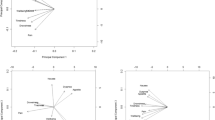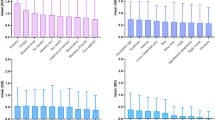Abstract
Goals of work
Cancer patients often experience multiple symptoms, many of which have been reported to correlate with each other. The goals of this study were to understand which cancer-related symptoms cluster together and to test the conceptual meanings of the revealed symptom clusters.
Patients and methods
Patients with various cancer diagnoses (N=151) were recruited from a medical center in northern Taiwan. The 13-item M.D. Anderson symptom inventory was used to assess patients’ symptom severity. Selected symptoms were factored using principal-axis factoring with oblique rotation. The known-group technique was used to validate the conceptual meanings of revealed factors.
Main results
Patients’ symptom severity ratings fit a three-factor solution that explained 55% of the variance. These three factors (symptom clusters) were named sickness symptom cluster, gastrointestinal symptom cluster, and emotional symptom cluster. Patients with pain and with advanced diseases had significantly higher mean scores in the sickness symptom cluster than patients without pain and with earlier-stage diseases. The patients’ functional status was negatively correlated with mean scores in the sickness symptom cluster. Patients under chemotherapy demonstrated significantly higher mean scores in the gastrointestinal symptom cluster than patients under other treatments. Patients with anxiety or depression also had significantly higher mean scores in the emotional symptom cluster than patients without anxiety or depression.
Conclusions
This study identified three underlying symptom clusters and verified their conceptual meaning in cancer patients. Knowing these symptom clusters may help healthcare professionals understand plausible mechanisms for the aggregation of symptoms.
Similar content being viewed by others
References
Armstrong TS, Cohen MZ, Eriksen LR, Hickey JV (2004) Symptom clusters in oncology patients and implications for symptom research in people with primary brain tumors. J Nurs Scholarsh 36(3):197–206
Bender CM, Ergun FS, Rosenzweig MQ, Cohen SM, Sereika SM (2005) Symptom clusters in breast cancer across 3 phases of the disease. Cancer Nurs 28(3):219–225
Chang AP (2003) Development and validation of the Brief Fatigue Inventory–Taiwan form and M. D. Anderson symptom inventory–Taiwan form. Master thesis, Taipei Medical University
Chang VT, Hwang SS, Feurman M, Kasmis BS (2000) Symptom and quality of life survey of medical oncology patients at a veteran affairs medical center: a role for symptom assessment. Cancer 88(5):1175–1183
Chen ML, Chang HK, Yeh CH (2000) Anxiety and depression in Taiwanese cancer patients with and without pain. J Adv Nurs 32:944–951
Chen ML, Chang HK (2004) Physical symptom profiles of depressed and non-depressed patients with cancer. Palliat Med 18(8):712–718
Chiang CY, Chen ML, Yu WP, Huang TH (2001) Physical and psychological distress of brain tumor patients receiving radiotherapy. Chang Gung Nurs 12:271–281
Cleeland CS, Bennett GJ, Dantzer R et al (2003) Are the symptoms of cancer and cancer treatment due to a shared biologic mechanism? A cytokine-immunologic model of cancer symptoms. Cancer 97:2919–2925
Cleeland CS, Mendoza TR, Wang XS et al (2000) Assessing symptom distress in cancer patients: the M.D. Anderson symptom inventory. Cancer 89(7):1634–1646
Dantzer R (2001) Cytokine-induced sickness behavior: where do we stand? Brain Behav Immun 15(1):7–24
Dodd MJ, Miaskowski C, Lee KA (2000) Occurrence of symptom clusters. J Natl Cancer Inst Monogr 32:76–78
Dodd MJ, Miaskowski C, Paul SM (2001) Symptom clusters and their effect on the functional status of patients with cancer. Oncol Nurs Forum 28(3):465–470
Gift AG, Jablonski A, Stommel M, Given CW (2004) Symptom clusters in elderly patients with lung cancer. Oncol Nurs Forum 31(2):203–212
Gift AG, Stommel M, Jablonski A, Given W (2003) A cluster of symptoms over time in patients with lung cancer. Nurs Res 52(6):393–400
Given B, Given CW, McCorkle R, et al (2002) Pain and fatigue management: results of a nursing randomized clinical trial. Oncol Nurs Forum 29(6):949–956
Given CW, Stommel M, Given B, Osuch J, Kurtz ME, Kurtz JC (1993) The influence of cancer patients’ symptoms and functional status on patients’ depression and family caregivers’ reaction and depression. Health Psychol 12(4):277–285
Hart BL (1988) Biological basis of the behavior of sick animals. Neurosci Biobehav Rev 12(2):123–137
Herrmann C (1997) International experiences with the hospital anxiety and depression scale—a review of validation data and clinical results. J Psychosom Res 42:17–41
Karnofsky DA, Burchenal JH (1949) The clinical evaluation of chemotherapeutic agents in cancer. In: MacLeod CM (ed) Evaluation of chemotherapeutic agents. Columbia University Press, New York, pp 196
Kelly KW, Bluthe R, Dantzer R et al (2003) Cytokine-induced sickness behavior. Brain Behav Immun 17:S112–S118
Kent S, Bluthe RM, Kelly KW, Dantzer R (1992) Sickness behavior as a new target for drug development. Trends Pharmacol Sci 13:24–29
Lin LH (2000) Screening for depression in cancer inpatients. Master thesis, Chang Gung University
McCorkle R, Quint-Benoliel J (1983) Symptom distress, current concerns and mood disturbance after diagnosis of life-threatening disease. Soc Sci Med 17(7):431–438
McCorkle R, Young K (1978) Development of a symptom distress scale. Cancer Nurs 1:373–378
Miaskowski C, Dodd MJ, Lee KA (2004) Symptom clusters: the new frontier in symptom management. J Natl Cancer Inst Monogr 32:17–21
Pett MA, Lackey NR, Sullivan JJ (2003) Making sense of factor analysis. Sage Publications, Thousand Oaks
Sarna L, Brecht ML (1997) Dimensions of symptom distress in women with advanced lung cancer: a factor analysis. Heart Lung 26(1):23–30
Zigmond AS, Snaith RP (1983) The hospital anxiety and depression scale. Acta Psychiatr Scand 67(6):361–370
Acknowledgements
This study was supported by a grant to Dr. Mei-Ling Chen from Chang Gung University (grant number CMRP1238). The authors thank all the study participants for sharing their experiences. The authors also thank Ms. Claire Baldwin for her help with editing this paper.
Author information
Authors and Affiliations
Corresponding author
Rights and permissions
About this article
Cite this article
Chen, ML., Tseng, HC. Symptom clusters in cancer patients. Support Care Cancer 14, 825–830 (2006). https://doi.org/10.1007/s00520-006-0019-8
Received:
Accepted:
Published:
Issue Date:
DOI: https://doi.org/10.1007/s00520-006-0019-8




